Katherine Langrish's Blog, page 36
May 22, 2012
Folklore Snippets: Fairy Hills
Robert Kirk, born about 1644, was the seventh son of a Scottish minister and became a minister himself, well known for translating the psalms into Gaelic and evangelising in the Highlands. He was extremely interested in the supernatural folklore of the areas, which like many of his time he felt were supporting evidence for the supernatural elements of Christianity, and is probably the only folklorist whose own death produced a legend!
He is said to have collapsed and died whilst walking on a fairy hill in his parish of Aberfoyle, and to have appeared after his death to one of his relatives to say that he was not dead but a prisoner in Fairyland. He gave instructions that he would appear again at the christening of his posthumous child, and asked his cousin to save him by throwing a knife over him and thus breaking the spell. Kirk duly reappeared when the company was at table, but his cousin was so astonished he forgot to act, and Kirk vanished, never to be seen again.
Here is the fairy hill in question...
 Doon Hill, Aberfoyle - from the churchyard where Kirk is buried. Photo http://faeryfolklorist.blogspot.co.uk...
Doon Hill, Aberfoyle - from the churchyard where Kirk is buried. Photo http://faeryfolklorist.blogspot.co.uk...
Here’s an extract from his book, The Secret Common-Wealth, 1691
(Pub. by The Folklore Society 1976)
There be manie places called Fayrie hills, which the mountain-people think impious and dangerous to peel or discover, by taking earth or wood from them; superstitiously beleiving the souls of their predecessors to dwell yr.
And for that end (say they) a Mote or Mount was dedicate beside everie Church-yeard, to receave the souls, till their adjacent Bodies arise, and so become as a Fayrie-hill. They using bodies of air when called abroad. They also affirm those Creatures that move invisibly in a house, and cast huge stones, but do not much hurt, (because counter-wrought by some more courteous and charitable spirits that are everywhere readie to defend men Dan 10, 13) to be Souls that have not atteaneed their Rest, thorough a vehement desyre of revealing a Murther, or notable injury don or received, or a Treasure that was forgot in their Lyftime on Earth, which when disclos’d to a Conjuror … the Ghost quite removes.
In the nixt Countrey to my former Residence about the year 1676, when there was some scarcity of grain, a marvellous illapse and vision struck the imaginatione of two Women in one night, living at a good distance from one other, about a Treasure hid in a hill called Sith bhruaich or Fairie-hill. The appearance of a Treasure was first represented to the Fancy and than an audible voice named the place where it was, to their waking senses. Whereupon they both arose and meeting accidentally at the place, discovered their design, and jointly digging, found a Vessel as large as a Scottis-peck full of small peecs of good money, of ancient coyn; which halving betwisxt them, they sold in dish-fulls for dish-fulls of meal to the Countrey people, varie many of undoubted credit saw, and had of the coyn to this day: but whither it was a good or bad Angell, one of the Subterranean people, or the restless soul of him who hid it, that discovered it, I leave to the examination of others.

He is said to have collapsed and died whilst walking on a fairy hill in his parish of Aberfoyle, and to have appeared after his death to one of his relatives to say that he was not dead but a prisoner in Fairyland. He gave instructions that he would appear again at the christening of his posthumous child, and asked his cousin to save him by throwing a knife over him and thus breaking the spell. Kirk duly reappeared when the company was at table, but his cousin was so astonished he forgot to act, and Kirk vanished, never to be seen again.
Here is the fairy hill in question...
 Doon Hill, Aberfoyle - from the churchyard where Kirk is buried. Photo http://faeryfolklorist.blogspot.co.uk...
Doon Hill, Aberfoyle - from the churchyard where Kirk is buried. Photo http://faeryfolklorist.blogspot.co.uk...Here’s an extract from his book, The Secret Common-Wealth, 1691
(Pub. by The Folklore Society 1976)
There be manie places called Fayrie hills, which the mountain-people think impious and dangerous to peel or discover, by taking earth or wood from them; superstitiously beleiving the souls of their predecessors to dwell yr.
And for that end (say they) a Mote or Mount was dedicate beside everie Church-yeard, to receave the souls, till their adjacent Bodies arise, and so become as a Fayrie-hill. They using bodies of air when called abroad. They also affirm those Creatures that move invisibly in a house, and cast huge stones, but do not much hurt, (because counter-wrought by some more courteous and charitable spirits that are everywhere readie to defend men Dan 10, 13) to be Souls that have not atteaneed their Rest, thorough a vehement desyre of revealing a Murther, or notable injury don or received, or a Treasure that was forgot in their Lyftime on Earth, which when disclos’d to a Conjuror … the Ghost quite removes.
In the nixt Countrey to my former Residence about the year 1676, when there was some scarcity of grain, a marvellous illapse and vision struck the imaginatione of two Women in one night, living at a good distance from one other, about a Treasure hid in a hill called Sith bhruaich or Fairie-hill. The appearance of a Treasure was first represented to the Fancy and than an audible voice named the place where it was, to their waking senses. Whereupon they both arose and meeting accidentally at the place, discovered their design, and jointly digging, found a Vessel as large as a Scottis-peck full of small peecs of good money, of ancient coyn; which halving betwisxt them, they sold in dish-fulls for dish-fulls of meal to the Countrey people, varie many of undoubted credit saw, and had of the coyn to this day: but whither it was a good or bad Angell, one of the Subterranean people, or the restless soul of him who hid it, that discovered it, I leave to the examination of others.
Published on May 22, 2012 01:37
May 18, 2012
THE ENCHANTED MIRROR
by SALLY PRUE
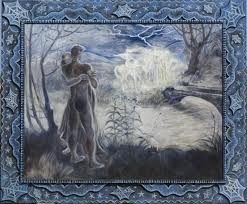
We didn’t lack books in my childhood home. I mean, we had a Bible, a Be-Ro cookery book, David Copperfield, Shakespeare, and, oddly, the collected poems of Walter de la Mare.
Mind you, of these only the cookery book was ever actually opened.
But we had a large blue set of Arthur Mee’s Children’s Encyclopaedias, too. I think they must have been my father’s. They were from the 1930s and extremely dull. Occasionally, though, the pages of dense text and murky photographs of the Queen Mary’s turbines were enlivened by brief re-tellings of classic tales.
Now, I must be honest here. As a child I had no taste. What I wanted from a story was, first of all a HAPPY ENDING, and secondly REALLY NICE CLOTHES. Ideally that meant princesses, but even a goose girl would do as long as her rags were elegantly tattered and her apron strings were blown into delectable volutes.
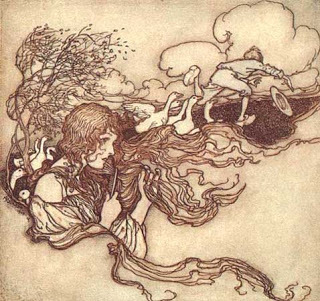
I very happily read all Arthur Mee had to say about Cinderella, Sleeping Beauty and The Ugly Duckling (a great favourite: I was the only girl in my class without fair hair and so I was constantly cast as the witch in our singing games. But oh, I thought, perhaps one day...).
Those were important stories. They introduced me to beauty in art. They taught me that the values of my family were not the values of the whole world. They taught me to hope.
For the time being, though, I was young, and therefore enslaved and helpless. To make matters worse the land of the princesses was plainly very far away. I knew of no real-life princesses except Princess Anne, and she seldom appeared swathed in acres of bouncing chiffon, which was surely the entire point of being a princess.
(Actually, Princess Anne never appeared in acres of bouncing chiffon. I just couldn’t begin to understand it. Reefer jackets?)
Now, unfortunately, Arthur Mee’s stories were not very many, and not very long, and I soon began to suffer from serious princess-starvation. Looking back, I can see that in the man’s world of the 1930s Arthur Mee had been generous to include any princesses at all. They were probably as unappealing to him as the Queen Mary’s innards were to me. But there it was: all too soon a thoroughly satisfactory story like Snow White would be followed by something about Camelot or Olympus which were dull dull dull, with few happy endings and fewer princesses, and those there were dressed in either their nighties (Olympus) or their dressing gowns (Camelot).
I realise that so far I have proved myself to have been the dullest, least numinous sort of child (so lacking in genius that I was quite unable to make anything at all of David Copperfield, Shakespeare, or Walter de la Mare) but I’m sorry to say that things are about to get even worse, because for my seventh Christmas my Cousin Ann bought me a copy of Chimney Corner Stories by Enid Blyton.
Now, I don’t think there are any princesses at all in Chimney Corner Stories, and Enid Blyton isn’t really interested in clothes, either: there’s one really shocking tale about a doll who cuts up her lace coat to make some curtains for a dolls house, an act of madness of which the author seems, astonishingly, to approve.
Still, Enid Blyton’s stories are solidly constructed and I found them extremely satisfying. By far the most marvellous thing of all, though, was that in several of the stories the elves come out of fairyland into our own world. One elf gives wishes to ordinary children (and I was, as we have seen, a very ordinary child) and another (actually I think it might have been a goblin) is banished from fairyland for wickedly stealing hairs from caterpillars to make paint brushes.
Now that was truly astonishing, because it meant that fairyland couldn’t far away at all. Those elves and gnomes were coming and going from fairyland to my world just as easily as I left home to go to school.
Think of that! Snow White’s country was clearly a long way away (and once upon a time, as well) but these gnomes were emerging from their fairyland straight into contemporary England – a rather smug version of contemporary England which included servants and ponies, true, but recognisable for all that.
Not only that, but when I looked at the fairies’ clothes (always the clothes!) I saw that some of them were wearing bellbine hats. Now, bellbine grows along municipal chain-link fencing everywhere in England. Why, bellbine even grew through the hedge between my house and the plastic bag factory!
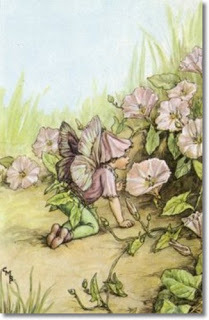
And if there were bellbine flowers, then perhaps...well, even Sir Arthur Conan Doyle (as I learned from the children’s TV programme Blue Peter) had believed there might be fairies at the bottom of the garden.
I searched and searched among the bellbine, and occasionally I saw something, or just missed seeing something, or heard a mysterious rustling, which might have been a fairy. It was enough to keep my new hopes alive.
When I got to the junior school I had access to more books, and my horizons widened accordingly. I learned about the wardrobe, of course (my parents’ wardrobe contained not one single fur coat and perhaps that was why it proved a continuing disappointment) and later, I suppose by this time at secondary school, I learned about Herne the Hunter in Windsor Great Park, and the god (or goddess) Sul who lives in the hot spring at Bath.
I learned about a very local haunting, Harcourt’s Chariot, which rattles precipitously down the Back Hollow from Ashridge to Aldbury.
I learned about the Romans’ lares and penates which guard boundaries and households. I found out about the green men who have been hiding in the foliage around us for so long that no-one knows any longer where they came from or why they are watching us.
This intrusion of otherworldly beings into my own England was startlingly different from the stories of Camelot and Olympus, and different from the stories of the princesses, too. Herne and Harcourt and the green men were here, now, close as breathing, casting shadows on my back. Mount Olympus might be a real place, but it was far beyond my reach (I’m sorry to say that the furthest we’d ever gone on a family holiday was Lyme Regis).
In any case, to visit the Olympians you needed Hermes’ wings, or Iris’s rainbow: there was no way, even in my wildest fantasies, I was going to find Apollo mooching about round the back of a plastic bag factory. (I admit that nymphs seemed to get about a bit, but nymphs were like Star Trek security men: shallow in character and soon dead.)
I was realistic enough to know, anyway, that even if I could get to Olympus or glum Camelot then none of those grand people – Lancelot or Zeus or Morgan Le Fay or Hera – was going to be the slightest bit interested in me. (If Adele Geras’s marvellous stories of the Greek gods had been available I might have felt differently about this, but, alas, they were yet to be written.)
So that left me with Herne the Hunter and various ghosts, pixies and green men – none of them, frankly, either snoggable or the sort of people you could take home to meet your parents. My interest in fairyland wobbled.
But then one day a boyfriend said do you like folk music? and put on a record. It was a song about a real place, Carterhaugh, where it is so easy to pass from England to fairyland that the tale begins with a warning:
Oh I forbid you, maidens a’ That wear gowd in your hair, To come or gae by Carterhaugh For young Tam-lin is there.
Tam-lin. And suddenly there it was, opening before me: a handsome prince grown close and dangerous, stepping out of the pages of a book and onto the real earth of my own country. Janet has kilted her green kirtle A little aboon her knee... And she’s awa to Carterhaugh As fast as she can hie.
And who, frankly, can blame her?
Oh yes, and suddenly the roots of fairyland were growing out and penetrating into real life again, into my life, for Janet is no beflounced princess, but a woman of warm blood and hot desire who knows what she wants and is prepared to fight to get it.
Yes. I discovered I was now old enough to journey far – and fight for what I wanted, too.
Fairyland had grown, just as I had, and yet again, like an enchanted mirror, it was showing me not my own reflection but my heart’s desire. Over the years it had presented to me visions of beauty, hope, escape, romance, and in the end courage.
And I’ll tell you something. That boyfriend never got away.When Sally Prue’s first novel, ‘Cold Tom’ won the Branford Boase Award and the Smarties Prize Silver Award in 2002, it was clear that a wonderful new writer of folklore-based fantasy had arrived. ‘Cold Tom’ taps into many legends and ballads about the fairies - the 'Tribe' which lives on the common.
Sally’s books remind me of Diana Wynne Jones who wrote books of otherworldly beauty – I’m thinking of ‘Power of Three’ and ‘The Spellcoats’ – as well as her more homely and amusing stories for younger readers. ‘Cold Tom’ and its recent prequel ‘Ice Maiden’ are YA reads: chilling, haunting, sharp-edged; but Sally is also the author of a trilogy of books for younger, ‘middle grade’ readers: the Truthsayer Trilogy. Sally's writing takes a look at our world from the outside, seeing ourselves as others see us. The Truthsayer Trilogy encompasses a variety of thought-provoking ideas about the nature of time and space, and besides the comedy, there are some tremendous moments of imagination and terror: as in the second book, 'The March of the Owlmen', when the knife-sharp, two-dimensional Owlmen come slicing into the world.
Her next book, out in 2012, will be called SONG HUNTER, a prehistorical novel set 40,000 years ago and featuring a Neanderthal group at the start of the last Ice Age.


We didn’t lack books in my childhood home. I mean, we had a Bible, a Be-Ro cookery book, David Copperfield, Shakespeare, and, oddly, the collected poems of Walter de la Mare.
Mind you, of these only the cookery book was ever actually opened.
But we had a large blue set of Arthur Mee’s Children’s Encyclopaedias, too. I think they must have been my father’s. They were from the 1930s and extremely dull. Occasionally, though, the pages of dense text and murky photographs of the Queen Mary’s turbines were enlivened by brief re-tellings of classic tales.
Now, I must be honest here. As a child I had no taste. What I wanted from a story was, first of all a HAPPY ENDING, and secondly REALLY NICE CLOTHES. Ideally that meant princesses, but even a goose girl would do as long as her rags were elegantly tattered and her apron strings were blown into delectable volutes.

I very happily read all Arthur Mee had to say about Cinderella, Sleeping Beauty and The Ugly Duckling (a great favourite: I was the only girl in my class without fair hair and so I was constantly cast as the witch in our singing games. But oh, I thought, perhaps one day...).
Those were important stories. They introduced me to beauty in art. They taught me that the values of my family were not the values of the whole world. They taught me to hope.
For the time being, though, I was young, and therefore enslaved and helpless. To make matters worse the land of the princesses was plainly very far away. I knew of no real-life princesses except Princess Anne, and she seldom appeared swathed in acres of bouncing chiffon, which was surely the entire point of being a princess.
(Actually, Princess Anne never appeared in acres of bouncing chiffon. I just couldn’t begin to understand it. Reefer jackets?)

Now, unfortunately, Arthur Mee’s stories were not very many, and not very long, and I soon began to suffer from serious princess-starvation. Looking back, I can see that in the man’s world of the 1930s Arthur Mee had been generous to include any princesses at all. They were probably as unappealing to him as the Queen Mary’s innards were to me. But there it was: all too soon a thoroughly satisfactory story like Snow White would be followed by something about Camelot or Olympus which were dull dull dull, with few happy endings and fewer princesses, and those there were dressed in either their nighties (Olympus) or their dressing gowns (Camelot).
I realise that so far I have proved myself to have been the dullest, least numinous sort of child (so lacking in genius that I was quite unable to make anything at all of David Copperfield, Shakespeare, or Walter de la Mare) but I’m sorry to say that things are about to get even worse, because for my seventh Christmas my Cousin Ann bought me a copy of Chimney Corner Stories by Enid Blyton.
Now, I don’t think there are any princesses at all in Chimney Corner Stories, and Enid Blyton isn’t really interested in clothes, either: there’s one really shocking tale about a doll who cuts up her lace coat to make some curtains for a dolls house, an act of madness of which the author seems, astonishingly, to approve.
Still, Enid Blyton’s stories are solidly constructed and I found them extremely satisfying. By far the most marvellous thing of all, though, was that in several of the stories the elves come out of fairyland into our own world. One elf gives wishes to ordinary children (and I was, as we have seen, a very ordinary child) and another (actually I think it might have been a goblin) is banished from fairyland for wickedly stealing hairs from caterpillars to make paint brushes.
Now that was truly astonishing, because it meant that fairyland couldn’t far away at all. Those elves and gnomes were coming and going from fairyland to my world just as easily as I left home to go to school.
Think of that! Snow White’s country was clearly a long way away (and once upon a time, as well) but these gnomes were emerging from their fairyland straight into contemporary England – a rather smug version of contemporary England which included servants and ponies, true, but recognisable for all that.
Not only that, but when I looked at the fairies’ clothes (always the clothes!) I saw that some of them were wearing bellbine hats. Now, bellbine grows along municipal chain-link fencing everywhere in England. Why, bellbine even grew through the hedge between my house and the plastic bag factory!

And if there were bellbine flowers, then perhaps...well, even Sir Arthur Conan Doyle (as I learned from the children’s TV programme Blue Peter) had believed there might be fairies at the bottom of the garden.
I searched and searched among the bellbine, and occasionally I saw something, or just missed seeing something, or heard a mysterious rustling, which might have been a fairy. It was enough to keep my new hopes alive.
When I got to the junior school I had access to more books, and my horizons widened accordingly. I learned about the wardrobe, of course (my parents’ wardrobe contained not one single fur coat and perhaps that was why it proved a continuing disappointment) and later, I suppose by this time at secondary school, I learned about Herne the Hunter in Windsor Great Park, and the god (or goddess) Sul who lives in the hot spring at Bath.
I learned about a very local haunting, Harcourt’s Chariot, which rattles precipitously down the Back Hollow from Ashridge to Aldbury.
I learned about the Romans’ lares and penates which guard boundaries and households. I found out about the green men who have been hiding in the foliage around us for so long that no-one knows any longer where they came from or why they are watching us.
This intrusion of otherworldly beings into my own England was startlingly different from the stories of Camelot and Olympus, and different from the stories of the princesses, too. Herne and Harcourt and the green men were here, now, close as breathing, casting shadows on my back. Mount Olympus might be a real place, but it was far beyond my reach (I’m sorry to say that the furthest we’d ever gone on a family holiday was Lyme Regis).
In any case, to visit the Olympians you needed Hermes’ wings, or Iris’s rainbow: there was no way, even in my wildest fantasies, I was going to find Apollo mooching about round the back of a plastic bag factory. (I admit that nymphs seemed to get about a bit, but nymphs were like Star Trek security men: shallow in character and soon dead.)
I was realistic enough to know, anyway, that even if I could get to Olympus or glum Camelot then none of those grand people – Lancelot or Zeus or Morgan Le Fay or Hera – was going to be the slightest bit interested in me. (If Adele Geras’s marvellous stories of the Greek gods had been available I might have felt differently about this, but, alas, they were yet to be written.)
So that left me with Herne the Hunter and various ghosts, pixies and green men – none of them, frankly, either snoggable or the sort of people you could take home to meet your parents. My interest in fairyland wobbled.
But then one day a boyfriend said do you like folk music? and put on a record. It was a song about a real place, Carterhaugh, where it is so easy to pass from England to fairyland that the tale begins with a warning:
Oh I forbid you, maidens a’ That wear gowd in your hair, To come or gae by Carterhaugh For young Tam-lin is there.
Tam-lin. And suddenly there it was, opening before me: a handsome prince grown close and dangerous, stepping out of the pages of a book and onto the real earth of my own country. Janet has kilted her green kirtle A little aboon her knee... And she’s awa to Carterhaugh As fast as she can hie.
And who, frankly, can blame her?
Oh yes, and suddenly the roots of fairyland were growing out and penetrating into real life again, into my life, for Janet is no beflounced princess, but a woman of warm blood and hot desire who knows what she wants and is prepared to fight to get it.
Yes. I discovered I was now old enough to journey far – and fight for what I wanted, too.
Fairyland had grown, just as I had, and yet again, like an enchanted mirror, it was showing me not my own reflection but my heart’s desire. Over the years it had presented to me visions of beauty, hope, escape, romance, and in the end courage.
And I’ll tell you something. That boyfriend never got away.When Sally Prue’s first novel, ‘Cold Tom’ won the Branford Boase Award and the Smarties Prize Silver Award in 2002, it was clear that a wonderful new writer of folklore-based fantasy had arrived. ‘Cold Tom’ taps into many legends and ballads about the fairies - the 'Tribe' which lives on the common.
Sally’s books remind me of Diana Wynne Jones who wrote books of otherworldly beauty – I’m thinking of ‘Power of Three’ and ‘The Spellcoats’ – as well as her more homely and amusing stories for younger readers. ‘Cold Tom’ and its recent prequel ‘Ice Maiden’ are YA reads: chilling, haunting, sharp-edged; but Sally is also the author of a trilogy of books for younger, ‘middle grade’ readers: the Truthsayer Trilogy. Sally's writing takes a look at our world from the outside, seeing ourselves as others see us. The Truthsayer Trilogy encompasses a variety of thought-provoking ideas about the nature of time and space, and besides the comedy, there are some tremendous moments of imagination and terror: as in the second book, 'The March of the Owlmen', when the knife-sharp, two-dimensional Owlmen come slicing into the world.
Her next book, out in 2012, will be called SONG HUNTER, a prehistorical novel set 40,000 years ago and featuring a Neanderthal group at the start of the last Ice Age.
Published on May 18, 2012 00:23
May 16, 2012
"Forsaken", the book trailer!
 "COME, dear children, let us away;
"COME, dear children, let us away;Down and away below.
Now my brothers call from the bay;
Now the great winds shoreward blow;
Now the salt tides seaward flow;
Now the wild white horses play,
Champ and chafe and toss in the spray.
Children dear, let us away.
This way, this way!"
The idea for "Forsaken" came from the classic poem 'The Forsaken Merman' by the late Victorian poet Matthew Arnold, which in turn is based on an old Scandinavian ballad. It tells the story of a merman who married a human woman, Margaret. They live together happily under the sea and she has children by him - till one day she hears church bells ringing and feels a sudden longing to go and pray in the 'little white church'. The merman agrees to part with her for a short while. But once on land she never returns to the sea, leaving her husband and children to grief for her. In Arnold's poem the merman says:
"Up the still, glistening beaches,
Up the creeks we will hie,
Over banks of bright seaweed
The ebb-tide leaves dry.
We will gaze, from the sand-hills,
At the white, sleeping town;
At the church on the hill-side—
And then come back down.
Singing: "There dwells a loved one,
But cruel is she!
She left lonely for ever
The kings of the sea."
The old belief about mermaids was that they had no souls. In order to preserve her immortal soul, Margaret is ready to desert her husband and children. Was she right to follow her beliefs? Or wrong to cause her loved ones so much pain?
Here's the trailer I made for the book. I filmed it (well, all except the underwater scene!) around the Farne Islands in waters full of seals...
In the original legend, the merman clambers into the churchyard to try and find his wife, but when he looks into the church, 'all the stone images turned their backs on him'. When I read this, a shiver ran down my spine and I knew I had to tell the story again - but this time, I wondered what would have happened if, instead of the merman, one of Margaret's own mer-children went to find her?
Thanks to Polly Carey who spoke the voiceover, and to Richard Hughes of We Are Goose , who composed and performed the music, and cut and edited the film. (You can compare it with the trailer we made for my book 'Dark Angels' if you click on the tab 'Book Trailers' at the top of this post. )
Please let us know what you think of it! :)
Published on May 16, 2012 00:51
May 14, 2012
Watermill Stories
I like stories about watermills. A watermill figured largely in my first two books, ‘Troll Fell’ and ‘Troll Mill’, and if you think about it, in past centuries the mill which ground your corn was about the most important building in any village after the church – and for similar reasons. The church provided your spiritual food, the mill provided your daily bread. The miller was an important man in any community. And like the church, the mill was a hub, a place where you could expect to meet your neighbours on a fairly regular basis, even the ones who lived on outlying farms.
Millers, like clergymen, were not always liked, of course. (The ones in my books certainly endear themselves to no one.) The song ‘I am a jolly miller and I live by myself’ has the refrain, ‘I care for nobody, no not I, if nobody cares for me,’ and rather suggests that millers felt themselves a little above the rest of the community. People couldn’t afford to offend the miller, whose mill with its machinery was one of the first non-cottage industries. No one wanted to go back to hand-grinding their own grain with a quern.
 Machinery at Venn Mill, Oxfordshire, just up the road from me and the model for Troll Mill! © Copyright Steve Daniels and licensed for reuse under this Creative Commons Licence
Machinery at Venn Mill, Oxfordshire, just up the road from me and the model for Troll Mill! © Copyright Steve Daniels and licensed for reuse under this Creative Commons Licence
This tension between the miller – whose hands were never dirty, but on the contrary who was always powdered in white – and the labouring villagers, may help explain the number of ghost stories and horror stories set around mills and millpond – but I think one also has to take into account the fact that a working mill is an impressive place. The whole building comes alive, full of purpose:
Everything vibrated. Old dust trickled and cobwebs shook on the walls. …And the noises were so spooky: the rhythmic thumping of the water wheel like a dark heart beating, the creaking machinery, the clatter of the shoe that shook down the grain, and the sibilant mutter of the rotating millstone.
(Troll Fell)
Here are a couple of folk-tales about watermills. One from Peter Asbjørnsen’s collection of Norwegian tales, East of the Sun and West of the Moon:
There was a man who had a flour mill, close to a waterfall, and there was a mill-goblin in that mill. Every time he went to grind his corn, the goblin got hold of the tub-wheel and stopped the mill, and he couldn’t get any corn ground. The man knew very well it was the goblin who had his hand in this and one evening when he went to the mill, he took a big pot full of pitch-tar with him and put it on the fire. He turned the water on to the wheel and the mill went for a while, but then it stopped as he had expected it would. He opened the door which led out to the wheel and there stood the mill goblin in the door, gaping. His jaw was so big that it reached from the threshold up to the lintel.
“Have you ever seen such a jaw?” said the goblin.
The man ran for the pot and pitched the boiling tar into the gaping jaw and said, “Have you ever felt anything do hot?”
The goblin uttered a terrible shriek and let go the wheel. He has never been seen or heard there after that time, nor has the mill been stopped since.
Serbia's most famous vampire, Sava Savanović, was said to have lived in an old watermill, where he drank the blood of the millers: Serbian folk legends held that water mills were an invention of the devil and a gathering place for demons – a belief which seems reflected by this tale from Ireland, from Great Blasket Island off the coast of County Kerry, told in Gaelic by a woman called Gobnait and written down by Robin Flower some time in the early 1900’s. ('The Western Island', Robin Flower, Oxford 1944) It’s an extract from a much longer tale, itself a version of ‘Mother Holle’, in which a king’s daughter is sent by her jealous stepmother to perform an number of difficult tasks, and succeeds though courtesy and goodness, while her ugly stepsister fails through rudeness and selfishness. For one task she is sent to a mill to get a bag of wheat ground: ‘and nobody in the world ever came back from that mill’. She has to stay there overnight:
And it wasn’t long till a tall, black man came down the chimney to her. “Stretch out your long white legs beside my long black legs.” “I’ll do it,” she said, “if you’ll make me a golden cupboard.” He wasn’t long in making it. “Stretch out your long white legs beside my long black legs.” “I’ll do it if you’ll make me a golden dresser.” “Stretch out your long white legs beside my long black legs.” “I’ll do it if you’ll make me a golden ladder.” Yerra, he hadn’t put the last nail in the ladder when the little cock flapped his wings and crowed, and the tall, black man went through the chimney.
Of course the stepsister makes the mistake of being rude, and ‘All he did was to gulp her up in his mouth and fly out of the chimney with her.’
Was it because of the elemental power of the water, that mills were regarded with awe? In contrast to the Serbian legends, here’s a poem attributed to the epigrammatist Antipator of Thessalonica, dated 85 BC: it celebrates the change from the wearisome female task of hand-grinding at home to the miraculous power of the water-driven millstones:
Hold back your hand from the mill, you grinding girls; even if the cockcrow heralds the dawn, sleep on. For Demeter has imposed the labours of your hands on the nymphs, who leaping down upon the topmost part of the wheel, rotate its axle; with encircling cogs it turns the hollow weight of the Nisyrian millstones. If we learn to feast toil-free on the fruits of the earth, we taste again the golden age...
Or, in an 18th century translation:
Ye Maids who toiled so faithfully at the Mill
Now cease your word and from these toils be still,
Sleep now till dawn and let the birds with glee
Sing to the ruddy morn from bush and tree
For what your hands performed so long and true
Ceres has charged the Water Nymphs to do.
Millers, like clergymen, were not always liked, of course. (The ones in my books certainly endear themselves to no one.) The song ‘I am a jolly miller and I live by myself’ has the refrain, ‘I care for nobody, no not I, if nobody cares for me,’ and rather suggests that millers felt themselves a little above the rest of the community. People couldn’t afford to offend the miller, whose mill with its machinery was one of the first non-cottage industries. No one wanted to go back to hand-grinding their own grain with a quern.
 Machinery at Venn Mill, Oxfordshire, just up the road from me and the model for Troll Mill! © Copyright Steve Daniels and licensed for reuse under this Creative Commons Licence
Machinery at Venn Mill, Oxfordshire, just up the road from me and the model for Troll Mill! © Copyright Steve Daniels and licensed for reuse under this Creative Commons Licence This tension between the miller – whose hands were never dirty, but on the contrary who was always powdered in white – and the labouring villagers, may help explain the number of ghost stories and horror stories set around mills and millpond – but I think one also has to take into account the fact that a working mill is an impressive place. The whole building comes alive, full of purpose:
Everything vibrated. Old dust trickled and cobwebs shook on the walls. …And the noises were so spooky: the rhythmic thumping of the water wheel like a dark heart beating, the creaking machinery, the clatter of the shoe that shook down the grain, and the sibilant mutter of the rotating millstone.
(Troll Fell)
Here are a couple of folk-tales about watermills. One from Peter Asbjørnsen’s collection of Norwegian tales, East of the Sun and West of the Moon:
There was a man who had a flour mill, close to a waterfall, and there was a mill-goblin in that mill. Every time he went to grind his corn, the goblin got hold of the tub-wheel and stopped the mill, and he couldn’t get any corn ground. The man knew very well it was the goblin who had his hand in this and one evening when he went to the mill, he took a big pot full of pitch-tar with him and put it on the fire. He turned the water on to the wheel and the mill went for a while, but then it stopped as he had expected it would. He opened the door which led out to the wheel and there stood the mill goblin in the door, gaping. His jaw was so big that it reached from the threshold up to the lintel.
“Have you ever seen such a jaw?” said the goblin.
The man ran for the pot and pitched the boiling tar into the gaping jaw and said, “Have you ever felt anything do hot?”
The goblin uttered a terrible shriek and let go the wheel. He has never been seen or heard there after that time, nor has the mill been stopped since.
Serbia's most famous vampire, Sava Savanović, was said to have lived in an old watermill, where he drank the blood of the millers: Serbian folk legends held that water mills were an invention of the devil and a gathering place for demons – a belief which seems reflected by this tale from Ireland, from Great Blasket Island off the coast of County Kerry, told in Gaelic by a woman called Gobnait and written down by Robin Flower some time in the early 1900’s. ('The Western Island', Robin Flower, Oxford 1944) It’s an extract from a much longer tale, itself a version of ‘Mother Holle’, in which a king’s daughter is sent by her jealous stepmother to perform an number of difficult tasks, and succeeds though courtesy and goodness, while her ugly stepsister fails through rudeness and selfishness. For one task she is sent to a mill to get a bag of wheat ground: ‘and nobody in the world ever came back from that mill’. She has to stay there overnight:
And it wasn’t long till a tall, black man came down the chimney to her. “Stretch out your long white legs beside my long black legs.” “I’ll do it,” she said, “if you’ll make me a golden cupboard.” He wasn’t long in making it. “Stretch out your long white legs beside my long black legs.” “I’ll do it if you’ll make me a golden dresser.” “Stretch out your long white legs beside my long black legs.” “I’ll do it if you’ll make me a golden ladder.” Yerra, he hadn’t put the last nail in the ladder when the little cock flapped his wings and crowed, and the tall, black man went through the chimney.
Of course the stepsister makes the mistake of being rude, and ‘All he did was to gulp her up in his mouth and fly out of the chimney with her.’
Was it because of the elemental power of the water, that mills were regarded with awe? In contrast to the Serbian legends, here’s a poem attributed to the epigrammatist Antipator of Thessalonica, dated 85 BC: it celebrates the change from the wearisome female task of hand-grinding at home to the miraculous power of the water-driven millstones:
Hold back your hand from the mill, you grinding girls; even if the cockcrow heralds the dawn, sleep on. For Demeter has imposed the labours of your hands on the nymphs, who leaping down upon the topmost part of the wheel, rotate its axle; with encircling cogs it turns the hollow weight of the Nisyrian millstones. If we learn to feast toil-free on the fruits of the earth, we taste again the golden age...
Or, in an 18th century translation:
Ye Maids who toiled so faithfully at the Mill
Now cease your word and from these toils be still,
Sleep now till dawn and let the birds with glee
Sing to the ruddy morn from bush and tree
For what your hands performed so long and true
Ceres has charged the Water Nymphs to do.
Published on May 14, 2012 00:45
May 8, 2012
Meeting the Hamaja'lu?
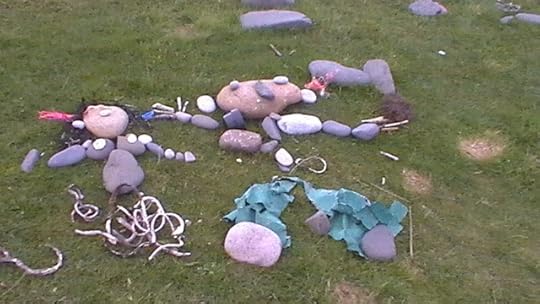
Life sometimes does imitate art, and without any explanations, either.
When I was writing 'Troll Blood' (the third part of my trilogy 'West of the Moon') I spent a great deal of time researching Mi'kmaq folklore. The Mi'kmaq are the Native American inhabitants of New Brunswick and Nova Scotia, and I thought their ancestors might well have encountered the Viking intruders who sailed from Greenland to North America - 'Vinland' - to cut timber. And I wanted to include legendary creatures from the beliefs of both nations - the Norse and the Native Americans - in my historical fantasy: and not merely frivolously, for such beliefs were an important part of the world picture of those peoples at that time, just as Christianity and other religious beliefs are for so many people today.
One of the traditions of the Mi'kmaq, documented by a researcher called Elsie Clews Parsons who talked to various Mi'kmaq people in the mid 1920's, was as follows:
Hamaja'lu
(Informant: Isabelle Googoo Morris)
These are very small beings, no larger than two finger joints. There are thousands of them who live along the shore. Water-worn, pitted stones are associated with them, "they have chewed in them, picked in them". Once when some men landed on shore for a short time, before they took to their boat again they saw a model of themselves and their boat made in stones by the hamaja'lu. They work very fast.
(Elsie Clews Parsons, 'Micmac Folklore', p 94, Journal of American Folklore Vol 38, 1925).

In 'West of the Moon', after consultation with a modern authority on Mi'kmaq folklore, and after considerable thought, I changed the name of these creatures to the wiklatmuj'k. She gave me much invaluable advice, and explained that 'hamaja'lu' is a word which has disappeared from the Mi'kmaq language since the 1920's, owing to repressive policies then in vogue for taking First Nations children away from their families, divorcing them from their heritage and punishing them for speaking their native tongue. Many words and traditions were lost, and 'hamaja'lu' was one of them. Wiklatmuj'k would be the word used today. Still, I'm glad to be able to provide the earlier usage here. (If you are interested in a longer discussion of my thoughts on the fictional use of folklore from other cultures, you can visit my post 'Cultural Appropriation and the White Saviour'.)
Anyway, use the legend I did: and here, somewhat abbreviated, is the passage from the book: an idyllic moment and something of a breathing-space between two episodes of violence and drama. Peer and Hilde, my hero and heroine, go for a walk on the beach in the moonlight with their Norse spirit-friend the Nis.
The moon was up, clear of the headland, casting sharp shadows. The beach ticked, clicked, pattered, as though thousands of little people were pecking and hammering among the stones. Peer looked harder. The gravel danced in patterns.
The Nis dashed past again, jinking and skipping making little rushes here and there, picking up stones. "What are you doing?" Peer called.
"Playing with the wiklatmuj'k," the Nis cried in a reedy voice like a birdcall.
"What did it say?" said Hilde.
"Look!" Peer pointed. Ahead, on a patch of smooth sand, someone had laid out figures in lines of pebbles. One had legs, one a triangular skirt.
"That's us," Hilde whispered... "Did the Nis do it?"
Peer shook his head. He straightened, his face alive with delight. "Hilde, the whole beach is full of tiny people. ...They're everywhere. But I can only see them when I'm not looking straight."
Hilde half-shut her eyes and peeped out of the corners. Nothing. Wait. there was something, scurrying about in the gravel. "It's crabs," she said.
"No it isn't," Peer insisted. "They're all over the place, knocking and chipping at the pebbles. Don't try so hard. Try looking at them the way you look at a very faint star."
The moonlit beach didn't change, but something happened behind Hilde's eyes. For a second she was doing something very difficult: seeing the stones all alive with hurrying busy little creatures, all tugging and pushing and rearranging the pebbles, making patterns and scattering them again. She saw their little black shadows, the size of her thumb.
Imagine my delight, then, when on a recent walk near the ruined castle of Dunstanborough, on England's North-East coast, I found these figures lined out in pebbles on the rough sea grass near the beach...
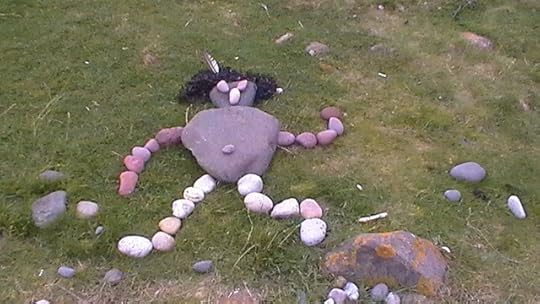
I don't know who made them...
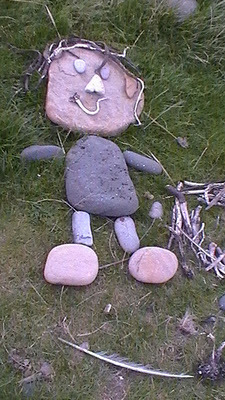
but several people must have been involved...
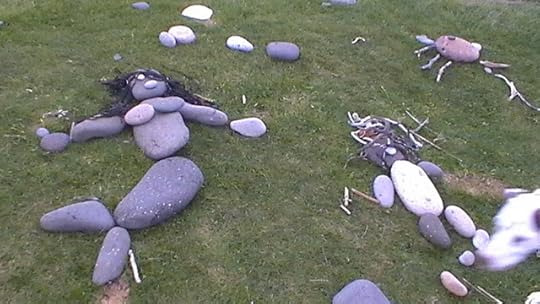
Here's a mermaid... and here's something quite scary:

Whoever did, it, I rather like the idea that they may have been very very small...

But they knew about cows... and Groucho Marx?
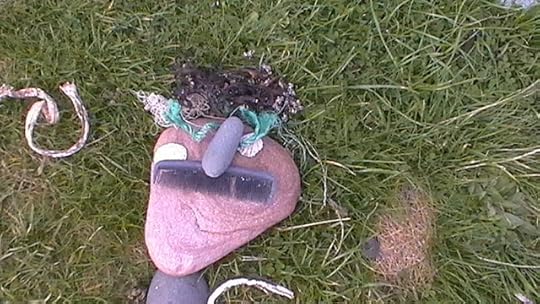
Don't you think making pictures out of pebbles must be one of the oldest, oldest forms of art? And still one of the most delightful?
Published on May 08, 2012 01:54
May 4, 2012
Rapunzel by Kate ForsythRapunzel is one of the most myst...
Rapunzel
by Kate Forsyth
Rapunzel is one of the most mysterious and enduring of all fairytales, telling the story of a young girl sold to a witch by her parents for a handful of bitter green herbs.
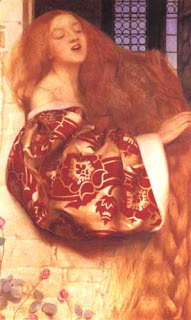 The witch locked her in a tower deep in the forest and visited her by commanding, ‘Rapunzel, Rapunzel, let down your hair, so I may climb the golden stair’. One day a prince, entranced by Rapunzel’s singing, called up the same rhyme to the imprisoned girl who lowered her hair to him. He climbed up to her room and they fell in love at first sight. Before the prince can help her escape, the witch discovers their tryst and banishes Rapunzel to the wilderness where she gives birth to twins (who are later cut from the story by the Grimm Brothers who found the babies hard to explain to a young audience). The prince is cast down from the tower and blinded by thorns, but Rapunzel finds him and her tears miraculously heal his eyes so they can live happily ever after.
The witch locked her in a tower deep in the forest and visited her by commanding, ‘Rapunzel, Rapunzel, let down your hair, so I may climb the golden stair’. One day a prince, entranced by Rapunzel’s singing, called up the same rhyme to the imprisoned girl who lowered her hair to him. He climbed up to her room and they fell in love at first sight. Before the prince can help her escape, the witch discovers their tryst and banishes Rapunzel to the wilderness where she gives birth to twins (who are later cut from the story by the Grimm Brothers who found the babies hard to explain to a young audience). The prince is cast down from the tower and blinded by thorns, but Rapunzel finds him and her tears miraculously heal his eyes so they can live happily ever after.
I have been fascinated by the Rapunzel tale ever since I was a child myself, and I've just published a novel called Bitter Greens which retells the fairytale as a historical novel set in Venice and northern Italy in the 17th century and France in the 18th century.
When I was two years old, I was savaged by a dog and ended up with terrible head injuries that resulted in meningitis (infection of the membranes that surround the brain) and encephalitis (a life-threatening inflammation of the brain). I was very ill for months, spending most of that year in hospital and ending with dreadful scars all over my head (thankfully most of them are hidden by my hair). I had half of one ear torn off and my left tear duct was destroyed, and with it my ability to control my tears. My eye wept all the time.
As a result, I was in and out of hospital for the next six or seven years, half-blind and racked with fever. I used to lie in my hospital bed, all alone in an empty children’s ward at the Sydney Eye Hospital, staring with my one good eye out the window. All I could see was a high green hill, crowned with an ancient Moreton Bay fig tree and the sandstone wall of the Art Gallery of NSW. It looked like a castle. I used to imagine myself galloping away over the hill, on my way to marvellous adventures.
I think my fascination with Rapunzel began with my own entrapment in that lonely hospital ward. Again and again I write about people imprisoned in towers and dungeons, longing to be rescued. It is a recurring motif in my novels, most recently in my fantasy adventure for children, The Wildkin’s Curse, which tells the story of a wildkin princess kept captive in an impossibly tall crystal tower, telling stories to try and free herself.
I love the story of Rapunzel because of the ardent love affair between the imprisoned girl and the prince who rescues her, and because of the miraculous healing of the prince’s eyes by Rapunzel’s tears. Rapunzel begins as a powerless child-like victim but by the end of the story she has become a magical agent of healing and redemption.
Most people think that Rapunzel was first told by the Grimm Brothers in the early 19th century, but in fact it is a much older story than that.
There are numerous Maiden in Tower stories in cultures all around the world, so many it has its own classification in the Aarne-Thompson fairytale motif index, Type 310. The first may well be from Christian iconography, with the story of Saint Barbara, a virtuous young girl locked in a tower by her father in the 3rd century. She was tortured for her beliefs, but all her wounds were miraculously healed overnight and in the end she was beheaded by her own father, who was then struck by lightning and killed.

The very first time the motif of the ‘hair ladder’ appeared in a fairy story was in a 10th century Persian tale told by Ferdowsi (932-1025 AD), in which a woman in a harem offers to lower her hair to her lover, Zal, so he can climb up to her. He is afraid he might hurt her and so throws up a rope instead.
The ‘hair ladder’ reappears in the story, Petrosinella, in the mid 17th century, as part of a collection of literary fairy tales told by a Florentine writer, Giambattista Basile. His collection, Lo cunto de li cunti (The Tale of Tales), was first published in 1634-36 and told the story of a princess who could not laugh. Various storytellers gathered to tell her stories in the hope they can amuse her, including one who tells the story of a girl, Petrosinella (Little Parsley), who is given up to an ogress after her mother steals parsley from the ogress’s garden. The ogress locks Petrosinella up in a tower in the forest, using her hair as a ladder to access the building. Petrosinella escapes with the help of a prince who heard her singing, overcoming the ogress by casting three magical acorns behind her that turn into obstacles that impede the witch and ultimately devour her.
Sixty years later, the story appears again, this time in France. It is told by a woman writer, Charlotte-Rose de Caumont de la Force, who has been banished to a convent after displeasing the king, Louis XIV, at his glittering court in Versailles. Locked away in a cloister, much like Rapunzel is in her tower, Charlotte-Rose was among the first writers to pen a collection of literary fairy tales and one of the world’s first historical novelists. Published under a pseudonym, Madame X, Charlotte-Rose’s tales became bestsellers and she was eventually able to buy her release.
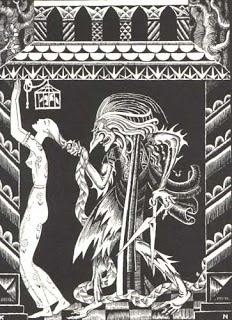
In Persinette, her version of the tale, the mother conceives an insatiable longing for parsley which her husband steals for her from a sorceress’s garden. Caught by the sorceress, he promises her his unborn daughter who the sorceress collects at the age of seven. Persinette is raised by the sorceress until she is twelve and then locked away in her tower (though the sorceress treats her gently and brings the child everything she could possibly want.) In time she becomes a woman; the prince hears her singing and chants the rhyme so he can climb up the ladder of hair to her room, where he seduces her (“he became bolder and proposed to marry her right then and there, and she consented without hardly knowing what she was doing. Even so, she was able to complete the ceremony” is how Charlotte-Rose rather coyly describes his seduction.)
Persinette becomes pregnant as a result, and in her naivety betrays herself to the sorceress when she complains about her dress growing tighter. The Grimm brothers later changed this to Rapunzel complaining about how much heavier the witch is than her prince - which at a single stroke makes Rapunzel seem extremely stupid.
Then Charlotte-Rose changes the ending so that the prince is blinded, Persinette bears twins in the wilderness, and then heals her lover’s eyes with her redemptive tears. The sorceress continues to torment them, until the young couple’s courage and tender love for each other move her to mercy and she magically returns them to the prince’s loving family.
This story was then retold in Germany by the German author Friedrich Schulz, which is almost identical to Charlotte-Rose’s story except that he changed the girl’s name to Rapunzel, perhaps because it is prettier than parsley. A rapunzel plant is a type of wild rampion. It was then retold by the Grimm Brothers in their 1812 fairytale collection, becoming less powerful, dark and sexy with each edition until we have the tale that most children know today (soon to be retold once again, and released as a Disney cartoon.)
It is Charlotte-Rose and her version which provide the inspiration for my book. She was a fascinating woman – strong-willed, intelligent and fiercely independent – who once rescued her lover from imprisonment by going into his parent’s castle with a travelling troupe of performers disguised as a dancing bear! How could I not write a book about her?
Kate Forsyth is the bestselling author of over twenty titles for children and adults. Her first book was named a Best First Novel of 1998 by Locus Magazine, and since then she’s been shortlisted for many awards, including a CYBIL Award in the US and the Surrey Book of the Year award in Canada. In 2007, five of her Chain of Charms series were jointly awarded the 2007 Aurealis Award for Children’s Fiction. Visit her website here: http://www.kateforsyth.com.au/
Illustrations of Rapunzel by Frank Cowper, Arthur Rackham and Kay Nielsen

by Kate Forsyth
Rapunzel is one of the most mysterious and enduring of all fairytales, telling the story of a young girl sold to a witch by her parents for a handful of bitter green herbs.
 The witch locked her in a tower deep in the forest and visited her by commanding, ‘Rapunzel, Rapunzel, let down your hair, so I may climb the golden stair’. One day a prince, entranced by Rapunzel’s singing, called up the same rhyme to the imprisoned girl who lowered her hair to him. He climbed up to her room and they fell in love at first sight. Before the prince can help her escape, the witch discovers their tryst and banishes Rapunzel to the wilderness where she gives birth to twins (who are later cut from the story by the Grimm Brothers who found the babies hard to explain to a young audience). The prince is cast down from the tower and blinded by thorns, but Rapunzel finds him and her tears miraculously heal his eyes so they can live happily ever after.
The witch locked her in a tower deep in the forest and visited her by commanding, ‘Rapunzel, Rapunzel, let down your hair, so I may climb the golden stair’. One day a prince, entranced by Rapunzel’s singing, called up the same rhyme to the imprisoned girl who lowered her hair to him. He climbed up to her room and they fell in love at first sight. Before the prince can help her escape, the witch discovers their tryst and banishes Rapunzel to the wilderness where she gives birth to twins (who are later cut from the story by the Grimm Brothers who found the babies hard to explain to a young audience). The prince is cast down from the tower and blinded by thorns, but Rapunzel finds him and her tears miraculously heal his eyes so they can live happily ever after. I have been fascinated by the Rapunzel tale ever since I was a child myself, and I've just published a novel called Bitter Greens which retells the fairytale as a historical novel set in Venice and northern Italy in the 17th century and France in the 18th century.
When I was two years old, I was savaged by a dog and ended up with terrible head injuries that resulted in meningitis (infection of the membranes that surround the brain) and encephalitis (a life-threatening inflammation of the brain). I was very ill for months, spending most of that year in hospital and ending with dreadful scars all over my head (thankfully most of them are hidden by my hair). I had half of one ear torn off and my left tear duct was destroyed, and with it my ability to control my tears. My eye wept all the time.
As a result, I was in and out of hospital for the next six or seven years, half-blind and racked with fever. I used to lie in my hospital bed, all alone in an empty children’s ward at the Sydney Eye Hospital, staring with my one good eye out the window. All I could see was a high green hill, crowned with an ancient Moreton Bay fig tree and the sandstone wall of the Art Gallery of NSW. It looked like a castle. I used to imagine myself galloping away over the hill, on my way to marvellous adventures.
I think my fascination with Rapunzel began with my own entrapment in that lonely hospital ward. Again and again I write about people imprisoned in towers and dungeons, longing to be rescued. It is a recurring motif in my novels, most recently in my fantasy adventure for children, The Wildkin’s Curse, which tells the story of a wildkin princess kept captive in an impossibly tall crystal tower, telling stories to try and free herself.
I love the story of Rapunzel because of the ardent love affair between the imprisoned girl and the prince who rescues her, and because of the miraculous healing of the prince’s eyes by Rapunzel’s tears. Rapunzel begins as a powerless child-like victim but by the end of the story she has become a magical agent of healing and redemption.
Most people think that Rapunzel was first told by the Grimm Brothers in the early 19th century, but in fact it is a much older story than that.
There are numerous Maiden in Tower stories in cultures all around the world, so many it has its own classification in the Aarne-Thompson fairytale motif index, Type 310. The first may well be from Christian iconography, with the story of Saint Barbara, a virtuous young girl locked in a tower by her father in the 3rd century. She was tortured for her beliefs, but all her wounds were miraculously healed overnight and in the end she was beheaded by her own father, who was then struck by lightning and killed.

The very first time the motif of the ‘hair ladder’ appeared in a fairy story was in a 10th century Persian tale told by Ferdowsi (932-1025 AD), in which a woman in a harem offers to lower her hair to her lover, Zal, so he can climb up to her. He is afraid he might hurt her and so throws up a rope instead.
The ‘hair ladder’ reappears in the story, Petrosinella, in the mid 17th century, as part of a collection of literary fairy tales told by a Florentine writer, Giambattista Basile. His collection, Lo cunto de li cunti (The Tale of Tales), was first published in 1634-36 and told the story of a princess who could not laugh. Various storytellers gathered to tell her stories in the hope they can amuse her, including one who tells the story of a girl, Petrosinella (Little Parsley), who is given up to an ogress after her mother steals parsley from the ogress’s garden. The ogress locks Petrosinella up in a tower in the forest, using her hair as a ladder to access the building. Petrosinella escapes with the help of a prince who heard her singing, overcoming the ogress by casting three magical acorns behind her that turn into obstacles that impede the witch and ultimately devour her.
Sixty years later, the story appears again, this time in France. It is told by a woman writer, Charlotte-Rose de Caumont de la Force, who has been banished to a convent after displeasing the king, Louis XIV, at his glittering court in Versailles. Locked away in a cloister, much like Rapunzel is in her tower, Charlotte-Rose was among the first writers to pen a collection of literary fairy tales and one of the world’s first historical novelists. Published under a pseudonym, Madame X, Charlotte-Rose’s tales became bestsellers and she was eventually able to buy her release.

In Persinette, her version of the tale, the mother conceives an insatiable longing for parsley which her husband steals for her from a sorceress’s garden. Caught by the sorceress, he promises her his unborn daughter who the sorceress collects at the age of seven. Persinette is raised by the sorceress until she is twelve and then locked away in her tower (though the sorceress treats her gently and brings the child everything she could possibly want.) In time she becomes a woman; the prince hears her singing and chants the rhyme so he can climb up the ladder of hair to her room, where he seduces her (“he became bolder and proposed to marry her right then and there, and she consented without hardly knowing what she was doing. Even so, she was able to complete the ceremony” is how Charlotte-Rose rather coyly describes his seduction.)
Persinette becomes pregnant as a result, and in her naivety betrays herself to the sorceress when she complains about her dress growing tighter. The Grimm brothers later changed this to Rapunzel complaining about how much heavier the witch is than her prince - which at a single stroke makes Rapunzel seem extremely stupid.
Then Charlotte-Rose changes the ending so that the prince is blinded, Persinette bears twins in the wilderness, and then heals her lover’s eyes with her redemptive tears. The sorceress continues to torment them, until the young couple’s courage and tender love for each other move her to mercy and she magically returns them to the prince’s loving family.
This story was then retold in Germany by the German author Friedrich Schulz, which is almost identical to Charlotte-Rose’s story except that he changed the girl’s name to Rapunzel, perhaps because it is prettier than parsley. A rapunzel plant is a type of wild rampion. It was then retold by the Grimm Brothers in their 1812 fairytale collection, becoming less powerful, dark and sexy with each edition until we have the tale that most children know today (soon to be retold once again, and released as a Disney cartoon.)
It is Charlotte-Rose and her version which provide the inspiration for my book. She was a fascinating woman – strong-willed, intelligent and fiercely independent – who once rescued her lover from imprisonment by going into his parent’s castle with a travelling troupe of performers disguised as a dancing bear! How could I not write a book about her?
Kate Forsyth is the bestselling author of over twenty titles for children and adults. Her first book was named a Best First Novel of 1998 by Locus Magazine, and since then she’s been shortlisted for many awards, including a CYBIL Award in the US and the Surrey Book of the Year award in Canada. In 2007, five of her Chain of Charms series were jointly awarded the 2007 Aurealis Award for Children’s Fiction. Visit her website here: http://www.kateforsyth.com.au/
Illustrations of Rapunzel by Frank Cowper, Arthur Rackham and Kay Nielsen
Published on May 04, 2012 01:28
May 1, 2012
Rapunzel for adults...
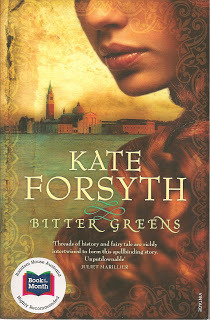 BITTER GREENS by Kate Forsyth
BITTER GREENS by Kate Forsyth Kate Forsyth first appeared on this blog a couple of years ago when I reviewed her enchanting children's fantasy 'The Puzzle Ring'. I'm very pleased to welcome her back this week, and to review her latest book - for adults this time - 'Bitter Greens'. It's a fabulous mix of history, fantasy and fiction: suitably, as its heroine is a storyteller par excellence, the French writer Mademoiselle Charlotte-Rose de Caumont de la Force (1654-1724), best known as the author of the fairytale ‘Persinette’ (1698), which later was adopted by the Brothers Grimm as the famous ‘Rapunzel’.
Born to Protestant parents, Mademoiselle de la Force found it too dangerous to retain that faith at the intolerant court of the Sun King, Louis XIV, who denied Protestants religious and political freedom and pursued policies of persection and forcible conversion.
She converted, therefore, but in 1697 her lively wit and romans à clef, along with a number of scandals and rumours, provoked the King to send her to the Benedictine abbey of Gercy-en-Brie, where she wrote her memoirs and a number of other novels.
Told in the first person, 'Bitter Greens' opens with Charlotte’s disgrace and journey to the abbey, where the nuns strip her of her elaborate court dress – so complicated in its fastenings she literally cannot undress herself – replacing it with a simple linen smock and shearing off her hair. Charlotte’s quick tongue and spirit get her into more trouble and she undergoes penances such as lying prostrate for hours on the cold stone floor of the chapel. In this misery, she finds a friend – an older nun, Soeur Seraphina, who takes her to work in the garden and begins telling her a story, the story of a young Venetian girl who was sold to a sorceress for a handful of bitter green herbs and shut up in a high tower…
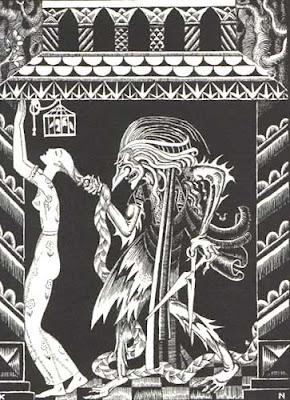 Rapunzel - Kay Nielsen
Rapunzel - Kay NielsenFrom this point on, the story of 'Bitter Greens' is inextricably interwoven with fiction and fantasy, complex as any braid of Rapunzel’s hair. There is Charlotte’s own personal history at the court of the Sun King. There is the tale of a Venetian courtesan and witch called Selena Leonelli, or La Strega Bella, who becomes the mistress of Titian and who prolongs her youth by drinking the blood of young virgins. And there is the tale of Marguerite, the child whom La Strega imprisons in the high tower.
Rich and magical as it is, this is frequently a very dark story. Kate Forsyth reminds us of the extreme powerlessness of most women – even those apparently most powerful and celebrated, the Queen herself, or the King’s mistresses, whose wealth and status depend entirely upon his favour. Charlotte-Rose’s mother is deprived of her chateau, freedom and family at the whim of the king. Servant women are raped against walls and left to get on with their work. Charlotte-Rose's talent and intelligence is no security: like any other lady she she must flirt and tease and scheme for a suitable marriage. And the streets – whether of 17th century Paris or 16th century Venice – are full of girls whose only livelihood is to sell themselves. It’s a world of casual brutality, revenge, desperation, plague and persecution. No wonder if there are dead babies and abandoned children. No wonder if some of the survivors turn to witchcraft.
Bitter Greens is a powerful tale about survival, and the endurance of hope, and the tales we tell ourselves to help us carry on. It’s fascinating that Charlotte-Rose wrote ‘Persinette’ while she herself was shut up in a convent: and in Kate Forsyth’s hands the tale of the child taken from her parents and shut up in a high tower has truly disturbing resonances, a reminder of some dreadful modern examples. Fairytales are not always pretty... Nevertheless, there is hope. Rapunzel escapes from her tower, and Charlotte-Rose did eventually return to Paris – where, Kate Forsyth tells us in the Afterword, she became a celebrated member of the salons and joined a secret society set up by the Duchesse de Maine called ‘The Order of the Honey Bee’ – whose thirty-nine members ‘wore a dark-red satin dress embroidered with silver bees and a wig shaped like a beehive.’ Now that is survival with style...
'Bitter Greens' is published in Australia by Random House/Vintage and can be purchased from http://www.fishpond.com.au/, which is the Australian version of Amazon, or any other Australian internet bookshop such as www.booktopia.com.au or www.dymocks.com.au
Published on May 01, 2012 01:58
April 30, 2012
A Monday poem
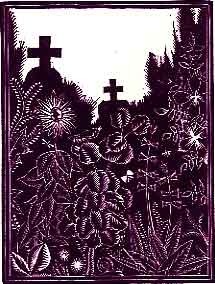 'The Ghost’ by Walter de la Mare
'The Ghost’ by Walter de la Mare
‘Who knocks?’ ‘I, who was beautifulBeyond all dreams to restore,I from the roots of the dark thorn am hitherAnd knock on the door.’
‘Who speaks?’ ‘I – once was my speechSweet as the bird’s on the air,When echo lurks by the waters to heed;‘Tis I speak thee fair.’
‘Dark is the hour!’ ‘Aye, and cold.’ ‘Lone is my house.’ ‘Ah, but mine?’‘Sight, touch, lips, eyes gleamed in vain.’‘Long dead these to thine.’
Silence. Still faint on the porchBrake the flames of the stars.In gloom groped a hope-wearied handOver keys, bolts and bars.
A face peered. All the grey nightIn chaos of vacancy shone;Nought but vast sorrow was there –The sweet cheat gone.
Published on April 30, 2012 02:47
April 27, 2012
The Arabian Nights
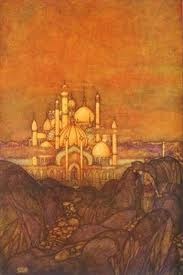 Eastern City by Edmund Dulacby John Dickinson
Eastern City by Edmund Dulacby John DickinsonThe cave of wonders! Torchlight glitters on piles of gems. It glows on jars of incense, on carpets, cloth, leather and canvas sacks that have split with the weight of coin and cascaded gold and silver across the floor. There’s pile upon pile of it, more than can possibly be counted, receding into the shadows. The light trembles. The hand the holds the torch shudders.
Where did all these things come from? The men that laid them here are fierce and cruel. Hanging on hooks among the silks, like a carcass at a market, are the dismembered quarters of an unlucky traveller who was seized and hacked to pieces for daring to enter the cave. The last drops of his blood still drip to black pools upon the floor. He died not long ago. His killers must be close by. What’s that noise? Is it sand, trickling in a crevice, or the hiss of indrawn breath? Is it gold that glitters from the deepest shadows - or is it blades of steel?
Surprisingly, Ali Baba may not one of the original stories in The Arabian Nights. Like Sinbad and Aladdin it may have been collected separately by Galland, the eighteenth century French traveller who popularised the Nights in Europe. But it’s one of my Arabian Nights – the Nights that have been with me since childhood. It was in the big, colourful, yellow-jacketed hardback book that my parents gave us and through which we entered that fantastic world. I can still remember the pictures, flat and stylised like Persian miniatures, and the way the robber chief throws up his arm before the cave as he cries “Open Sesame!”
So many stories! Ali Baba and his slave-girl Morgiana, and thirty-nine thieves dead in their jars of oil. Aladdin and his lamp. The Sultan Haroun al Raschid and his vizier Jafaar. The hunchback and the bone he choked upon. The brothers Aboukir and Abousir, and the city where the dyers only know how to colour things blue. Turbans and curling beards and gongs and incense. Cunning and beauty and terrible cruelty. This was fantasy, an other world far removed from Western living-rooms, long before Tennyson wrote his Idylls or Tolkien woke our Northern myth from its slumber.
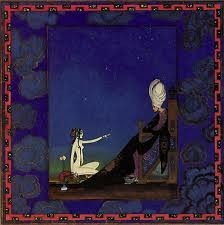 Scheherezade by Edmund Dulac
Scheherezade by Edmund DulacAnd Scheherazade herself. The young woman who, night after night, tells the stories to her husband the Caliph, knowing that if she ever loses his interest she will be executed in the morning like all his other wives before her. In the sweltering darkness she whispers to him, and he listens with his head propped on silken pillows as she ends one tale and begins another, only to fall silent just as her royal murderer is begging for more. Young as she is, she has mastered the art of the cliffhanger. (I never asked myself, when I had that yellow book in my hands, what else she might have known about amusing men in bed. Nor did I wonder if the Caliph’s problem with women might have stemmed from some very private little problem of his own, and the reason the stories worked for him was because nothing else was going to. Sad creature that I am, I can think these things now. )
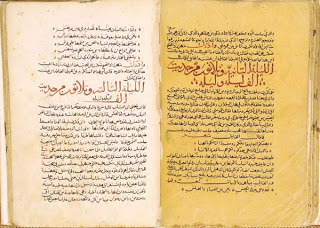 14th C manuscript of the Thousand and One Nights, Bibliotheque Nationale, Paris
14th C manuscript of the Thousand and One Nights, Bibliotheque Nationale, ParisA thousand stories! I’m a storyteller myself, and used to being asked about my ideas. But where did she get all hers from? Maybe she walked at dawn through in the peacock gardens, her brain dull from fear and lack of sleep, plotting the twists and turns that would keep her alive for one night more. That story about the sailor went well. It must be worth a sequel or two. Is seven pushing it too far? All right, but what’s he going to do on his seven voyages? (Bird flies by with mouse dead in its claws) That’s it! Birds! Big birds, big enough to feed on elephants! That’ll make him sit up. That will get me one more dawn like this. One more…
Stories inside stories inside stories. Scheherazade tells of Jafaar the vizier, who, found wanting by his master Haroun, obtains a pardon for himself by entertaining his Caliph with the Tale of Nur al-Din Ali. (No harm, you can hear Scheherazade thinking, in planting the idea of mercy in her own Caliph’s head). The Fisherman tells the Djinn the story of the sage Duban. Sinbad the Porter hears the story of the seven voyagers from his namesake the Sailor. It’s like Russian dolls, one inside another inside another, and each decorated and striking, and the myriad of voices that tell them seem to come from all around, echoing inside the cave.
 Sufi imam from the Thousand and One Nights, 14th C manuscript
Sufi imam from the Thousand and One Nights, 14th C manuscriptA thousand and one stories? Some collections have as many – ancient tales that go back into the folklore of different Middle Eastern cultures, including some about historical figures who lived long after Sheherazade and her Caliph are supposed to have existed. But most tellings have only a selection. Ours probably included no more than twenty. Some I recall very clearly. Other stories have elements I remember or half-remember, like tricking the djinn back into the bottle, or the book whose pages are poisoned, or the Caliph who enters a house in disguise, is entertained, and nearly loses his life. I must have read those stories and then forgotten them. Or maybe I never did, but others like Umberto Eco and James Elroy Flecker did at some time and have served them up to me since, set like gems in stories of their own making. Running my eye down the list of a thousand titles, I’m surprised to see how few I can recognise. The Nights were part of my childhood, and yet what I have is only a small proportion of what is there. They are the piles upon piles of untouched treasures that I left behind me in the cave when I escaped with my little bag of jewels all those years ago.
John Dickinson is the son of the author Peter Dickinson, and worked in the Ministry of Defence, Cabinet Office and NATO before leaving the civil service to begin writing. His brilliant YA fantasy novel ‘The Cup of the World’ and its sequels ‘The Widow and The King’ and ‘The Fatal Child’ are set in a far-off, war-troubled medieval kingdom where once, long ago, Wulfram the Seafarer came with his seven sons and conquered the land. Now the different baronies and territories descended from those sons are in turmoil and open revolt, bitter with complex politics and grudges. John has also published a historical novel for adults, ‘The Lightstep’, set in a German palatinate at the time of the French Revolution (one of the best adult novels I read last year) - and a coldly beautiful science fiction novel called ‘WE’. His forthcoming book 'Muddle and Win, the Battle for Sally Jones', is a sort of 'Screwtape Letters' for children, in which a small devil and a guardian angel slug it out for the soul of good girl Sally Jones. It will be out in September.
John Dickinson is also over at Fantabulous Fridays, Scribble City Central, this morning, talking about 'D for Devil' - I'm heading over there now!
Published on April 27, 2012 00:46
April 23, 2012
Are We Underestimating Children?
 My own well-loved copy of The Tale of Mr TodFriends of mine who are children’s authors were recently having a conversation about words their editors had asked them to alter, or explain, on the grounds that children would be puzzled by them. Among these were some horse-riding and falconry terms. And I’ve had the experience myself: writing about Viking ships in ‘Troll Blood’, for instance, I was asked to weed out or else explain some of the nautical terminology – ‘reefing a sail,’ for instance, and ‘a lee shore’ and other sailorly commands such as ‘luff’ or ‘jibe’.
My own well-loved copy of The Tale of Mr TodFriends of mine who are children’s authors were recently having a conversation about words their editors had asked them to alter, or explain, on the grounds that children would be puzzled by them. Among these were some horse-riding and falconry terms. And I’ve had the experience myself: writing about Viking ships in ‘Troll Blood’, for instance, I was asked to weed out or else explain some of the nautical terminology – ‘reefing a sail,’ for instance, and ‘a lee shore’ and other sailorly commands such as ‘luff’ or ‘jibe’.Fair enough, you may think: we don’t want to be obscure. But it's worth asking: do children really stop in their tracks – or worse, derail – when they come across an exotic word they don’t understand? I doubt it. When I read an unusual word as child, one of four things would happen:
(A) I would semi-skip over it. This is the best option for things like: “‘Luff, you lubbers! Haul on those sheets!” roared the captain, as the sail went aback”: I didn’t have to know the exact meaning of the words; I could see that the ship was in difficulties and the captain was worried, and that was enough. Luff and lubbers and aback, and their ilk, got stuffed into a mental category of ‘mysterious words that sailors use’. (As did ‘ilk’, in fact. And that’s pretty much where they still are.)
In 'The Tale of Mr Tod', I didn't worry when I came across: " 'My Uncle Bouncer has displayed a lamentable want of discretion for his years,' said Peter reflectively" - I got the point that Peter was criticising Mr Bouncer, and skipped on to the next bit, which was clear enough: "...'but there are two hopeful circumstances. Your family is alive and kicking; and Tommy Brock has had refreshment. He will probably go to sleep and keep them for breakfast.'" I used to read this book aloud to my bears when I was six.
(B) I would pick up the meaning from the context. On reading that the Flopsy Bunnies fell asleep because lettuce is ‘soporific’, I didn’t go to the dictionary, neither did I make a conscious mental note that soporific must mean something to do with making you sleepy; the word merely took on a contextual colour, or flavour, which I would recall the next time I encountered it. Children are good at making these associative leaps because this is how they learn their own language anyway. It may lead to the occasional misapprehension, but such things are generally cleared up by experience.
(C) I would ignore the word entirely and carry on, which is what I still do if I’m reading – say – a 19th century literary essay with bits of original Greek poetry dropped in here and there.
Lastly:
(D) I would carry the book to my mother and ask, “What does this word mean?”
All four of these options are perfectly legitimate and we ought to be making sure children feel OK about employing them. A healthy reader should be like a healthy cross-county runner whose steady pace is not interrupted by obstacles and stumbling blocks. A confident child reader should have the toughness and elasticity to leap over the odd unusual word and keep going. And how are they going to acquire that confidence if every text they read has been raked and weeded flat?
When I was small, the King James Bible was standard reading for everyone. At the age of seven my classmates and I were expected to learn pieces of prose and poetry by heart. One week it was this:
“Once upon a time there were four little rabbits and their names were Flopsy, Mopsy, Cottontail and Peter. They lived with their mother, old Mrs Rabbit, in a sandbank, underneath the roots of a very big fir tree…”
And the next week it was this:
“The beauty of Israel is slain upon thy high places: how are the mighty fallen!
Tell it not in Gath, publish it not in the streets of Askelon, lest the daughters of the Philistines rejoice; lest the daughters of the uncircumcised triumph.
Ye mountains of Gilboa, let there be no dew,
neither let there be rain upon you, nor fields of offerings,
For there the shield of the mighty is vilely cast away…”
I can still recite the whole of David’s lament for Saul and Jonathan, and I loved it as much when I was seven as I do now – maybe even more, in fact. “They were swifter than eagles; they were stronger than lions…”
Did I know what ‘uncircumcised’ meant? Of course not; I didn’t have a clue: and certainly no grown-up offered to explain it to me. IN CONTEXT, however, I understood perfectly well that it was a pejorative. Clearly the daughters of the uncircumcised were – for David – the daughters of people he disapproved of. That was enough for me at the time; nor does a clearer understanding of the procedure of circumcision add anything essential to this beautiful and troubled lament.
And Gath and Askelon and Gilboa – where were these? Again I didn’t know, but again it was obvious from the context they were towns or cities, and their names were beautiful – and just hearing about them made the world wider and more mysterious and exciting.
Don't worry, I'm not suggesting we return to making children learn swathes of the Bible by heart. But I am suggesting that the best way to learn something is to do it yourself, not to have it always done for you. Instead of worrying about individual words and their possible difficulty, shouldn’t we encourage children to throw themselves into a story and keep going to the end in spite of the odd word they don’t quite understand? Learning not to be afraid of strange words is exactly like getting down the length of the swimming pool without minding the odd wave that hits you in the face.
You discover your own ability, and it’s more fun that way.
Published on April 23, 2012 00:04



